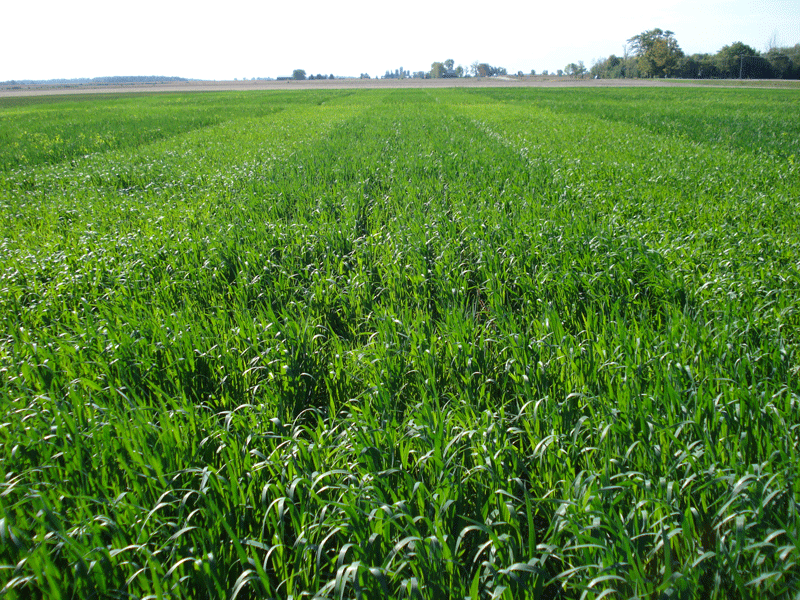Keeping weeds in the dark
UTILIZING COVER CROPS
SEEING EVEN THE tiniest sliver of sunlight is all most weed seeds need to germinate — but if they sense that there is a thick plant canopy above them, they won’t emerge.

That is why a new study led by researchers from the University of Guelph and the Ontario Ministry of Agriculture, Food and Rural Affairs (OMAFRA) is looking at new management methods aimed at controlling weeds by keeping them in the dark.
Plant Agriculture professor and weed scientist Dr. Francois Tardif and OMAFRA weed specialist Mike Cowbrough have teamed up on a four-year project they call, “Fight the Light.”
The researchers are hoping to find out whether reducing the amount of sunlight reaching the soil surface, with plant canopies, can dramatically cut back on the amount of weed seed germination and seedling success in a typical field.
Tardif says the idea for Fight the Light came about in response to the need for growers to look into alternative management systems to combat the rising threat of resistant weeds — especially when there are no new herbicide modes of action coming to market any time soon.
“We’re not trying to replace the herbicides, we’re trying to reduce the dependency on them and the likelihood of selective resistance developing,” he explains. “Weed resistance is really a numbers game — the more weeds you have in your field, the more chance you have of finding that one random, genetic mutant that’s going to be resistant to what you’re spraying.”
PREVENTING GERMINATION
Fight the Light focuses on the cropping and post-harvest phases. During cropping, the researchers are experimenting with increases in seeding density, promoting strong early growth with high rates of fertilizer at planting, and using cultivars that will branch more and close canopy quickly. Then, after the crop has been harvested and the soil is bare, cover crops are seeded to provide additional shading.
Taken together, Tardif explains that all of these methods have one thing in common — to create a lush, thick canopy that shades the soil and prevents weed seeds from germinating.
However, he is quick to point out that the conventional farming practices of today have been giving weeds more than enough light to thrive.
“Basically what we’ve been doing is giving weeds enough light so they can germinate en masse and then relying on the herbicide to come through for us,” he says. “But if you think about it, you could actually have pigweed coming up at 1,000 seedlings per square metre in your field — so you’re creating lots and lots of chances for resistant weeds.”
He says that if growers establish a strong plant canopy or plant cover crops, there is a chance that they could dramatically reduce their chances of getting resistance, while also cutting back selection pressure.
TEST PLOTS
To test out each of the Fight the Light approaches, Tardif and Cowbrough have set up four sets of plots in Elora with identical corn, soybean, and wheat rotations.
“We’ve had different scenarios where we started with regular practices and then started building up the seeding density, applying nitrogen, or using different cultivars to see what yielded a difference,” says Tardif.
For example, the first of the plots follows a basic three-crop rotation, with corn at 34,000 seeds per acre, followed by 177,000 seeds per acre of soybeans at conventional tillage, and 1.5 million seeds of wheat with no tillage.
Then, they follow that with a second rotation with higher seeding densities — 42,000 corn seeds per acre, 235,000 soybean seeds per acre, and two million wheat seeds per acre.
Tardif explains that the most built-up of the Fight the Light approaches adds in cover crops, such as crimson clover and rye grass, to the corn and wheat to create a wider canopy over the soil.
Currently, he and Cowbrough already have a year’s worth of data under their belt and plan to run their Fight the Light rotations for the next three years to determine whether their approaches are consistently able to reduce weed seed germination.
Even though it is quite early on in the study, Tardif and Cowbrough are encouraged at some of the early data they are getting from this past year.
“We already have a sense that planting density with soybeans may not be the best way to go, but applying fertilizer earlier to help close canopy may be helpful,” explains Tardif.
“It’s not one of those projects where you’re going to get instant answers,” he adds. “But what we want is — especially as we get to the end of the treadmill with herbicides — to get a better sense of what alternative methods work and what doesn’t.”
This research receives funding and support from the Ontario Ministry of Agriculture, Food and Rural Affairs, Grain Farmers of Ontario, and Pioneer Hi-Bred. •

















